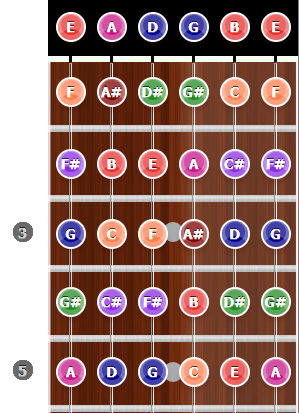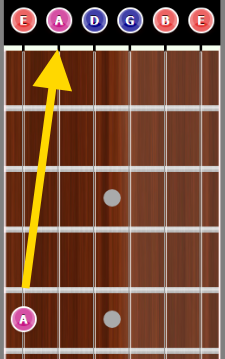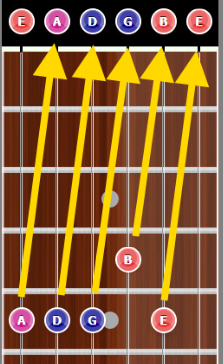How to tune a guitar (without a tuner)
A guitar's standard tuning is: EADGBe
One thing that makes the guitar a unique instrument is that some notes reside on more than one string.
Below is an example of all the notes on the first 5 frets:

Do not get overwhelmed by the graphic. It shows you all the notes, I wanted to show you how the same notes reside on more than one string.
For example, on the low E (6th) string, the fifth fret (in pink/fushia) is an A note.
That A note is the same as the open A on the A (5th) string.
Here is a graphic of the 6th string A and the 5th string A:

To tune the A (5th) string on your guitar, fret the 5th fret on the E (6th) string.
Play the target pitch on the 6th string, and move the A string's tuner until they match.
If the A (5th) string is lower than the target pitch on the low E (6th) string, turn the tuning peg to sharpen the open A note.
If it's lower, loosen the tuning peg, to flatten the open A note.
A quick tip is to tune using the target pitch first. But check it again by hiting the open A, then the target notes on the E.
You may find that it sounds right if you only do it one way, because your ear got use to it sounding that way.
Playing it in reverse gives your ear a new perspective on the same notes to see if they really match.
Next we can use the 5th fret on the A (5th) string to tune the D (4th) string.
After that, you can tune the G (3rd) string using the 5th fret on the D string.
Tuning (The one exception)
As with everything, there are exceptions to the rule.
The one exception to the 5th fret method, is the G (3rd) string to B (2nd) string.
For this string, we need to fret the 4th fret on the G (3rd) string to get the B note.
After tuning the B, you go back to the 5th fret on the B (2nd) string to tune the high E (1st) string.
Here is a graphic of how to tune all the strings based on the notes on the string next to it.

At this point, your guitar should be in tune, and you're ready to play.
Tuning Tip
One tip to tuning is to always tune "up", and never tune down.
This most likely sounds confusing. How do I tune "up" if the note is already sharp?
If the string you are tuning is sharper than the source, flatten the string passed the source note.
Then tune the string up to match the source note.
The way that guitar tuning pegs work is basically a gear. The tuning peg turns, which turns a gear,
and that gear turns the post that changes the pitch of the string.
The gears of the tuning pegs may not be completely snug to each other. There may be some play in the gears.
So, if you tune down, the gear might not be snug, and soon the gears with move, thus putting the string out of tune.
To combat this scenario, tuning "up" solves this situation, because the gears remain snug while tuning up.
WRAP UP
Tuning is a matter of matching the open string with the source string (example: Open A to E string 5th fret).
The downside to this method that the guitar will be tuned relative to the source string.
For example, if the source string isn't in tune, in this case the low E (6th) string,then the entire guitar is
in tune to itself, but might not be in tune to standard tuning.
Try to use a reference tone when tuning the lowest string. Tune the lowest note to the reference tone.
Then tune the rest of the guitar as you normally would. This should make your guitar in standard tuning.
/
At this point, your guitar should be truly in standard 440 tuning, and you're ready to play with any song.